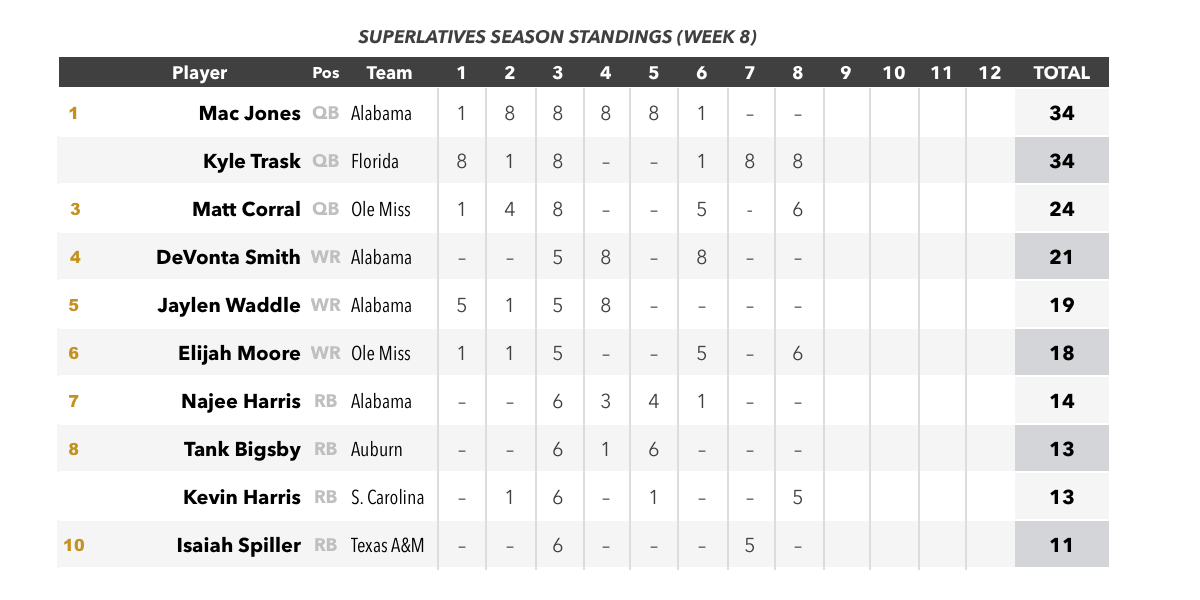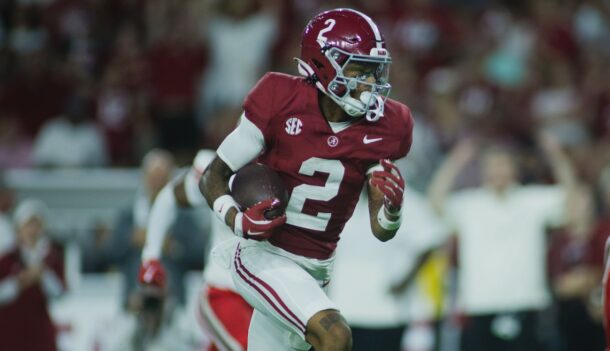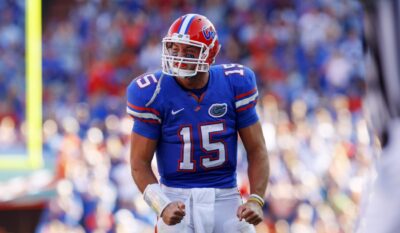
Monday Down South: Will Muschamp meets a fate years in the making
By Matt Hinton
Published:
Weekly takeaways, trends and technicalities from the weekend’s action.
12 months late and $15 million short
Ole Miss 59, South Carolina 42. This game, like many games in this year of super-charged offenses, was governed by pure video game logic: 1,256 combined yards, 59 first downs, 16 plays that gained 20+ yards, 14 touchdowns, 3 punts, zero brakes. There was a 200-yard rusher on one side (Carolina’s Kevin Harris), a 200-yard receiver on the other (Ole Miss’ Elijah Moore, for the second consecutive week) and 3 other players who accounted for more than 100 scrimmage yards. Ole Miss QB Matt Corral set the single-game school passing record with 513 yards on a absurd 16.0 per attempt. The Rebels recorded their first game ever with 700+ total yards vs. an SEC opponent. Lane Kiffin nearly hurled his playsheet into orbit.
See if you can spot when Lane Kiffin's clipboard goes flying on this Ole Miss touchdown. pic.twitter.com/FQIKOcgG2h
— The Comeback (@thecomeback) November 15, 2020
That kinda night. And if you’re a spectator, in a game with absolutely no bearing on the conference standings, on a weekend when most of the league was sidelined by COVID-19, that’s all you can really ask for.
If you happen to have been rooting for South Carolina … not so much. The decision reportedly was made the previous week, but Saturday night was the point of no return for Will Muschamp, who was finally handed his walking papers on Sunday, $15 million buyout and raging pandemic be damned. (Combined with the sum Florida owed him after sending him packing in 2014, Muschamp is set to bank more than $21 million in buyout money alone in a little less than a decade.) He goes out with a 28-30 record in 4-plus years, dragged down by a 6-13 mark over the last 2. The Hugh Freeze Watch in Columbia is officially under way.
In the end, Muschamp goes out as a defensive coach with a defense in free fall. Since their Oct. 17 upset over Auburn, the Gamecocks have been outscored 159-69 over the course of a 3-game losing streak, at the hands of LSU (which put up 52 points on 541 yards behind a true freshman QB in his first career start), Texas A&M (48 points on 530 yards, the game that sealed his fate), and an Ole Miss team that moved the ball essentially at will (59 points on 708 yards).
Remarkably, South Carolina hasn’t been hit as hard by COVID as most teams – no notable opt-outs before the season, no postponed games, no significant attrition involving key players in a campaign that’s supposed to be as much about survival as anything else.
And yet: At 2-5, the Gamecocks have no identity and are almost guaranteed to finish with a losing record for the second year in a row – ESPN’s Football Power Index tabs them as underdogs in each of their last 3 games against Missouri, Georgia and Kentucky – setting up a rerun of last year’s deflating 1-5 finish following a midseason upset at Georgia.
A lot of us started writing the obits for the Muschamp era in the midst of that run, before he was granted an unlikely reprieve. That’s how long the end has been in sight. Now that the time has come, it’s just a matter of cut-and-paste with a few minor updates.
All told, Muschamp spent close to half his 5-year tenure on the hot seat, with all of the maneuvering that entails: He endured the obligatory coordinator purge, restructured his buyout and cast his lot with a grad-transfer QB over his own fledgling recruits. The arrow never budged.
Wikipedia has already made Will Muschamp the Tennessee defensive coordinator. pic.twitter.com/P9qnSnmRKW
— Andy Staples (@Andy_Staples) November 16, 2020
For whoever comes next — SDS’ Matt Hayes reported Freeze tops the wish list — the rebuild will be a challenge on a couple of levels, beginning with expectations. Muschamp was always a placeholder hire, but the fan base remembers better times. Technically, the Gamecocks are less than a decade removed from their peak years under Steve Spurrier, who delivered a division title in 2010, 3 straight top-10 finishes from 2011-13, and 5 straight wins over Clemson from 2009-13. This was the era of Jadeveon Clowney, Marcus Lattimore, Alshon Jeffery and Stephon Gilmore – all home-grown stars made good, proof that South Carolina can compete for and with elite local talent.
But those days seem a lot further in the past than the calendar suggests. Recruiting fell off hard at the tail-end of the Spurrier years and has never really recovered; the program Muschamp inherited in 2016 was in dire straits barely 2 years removed from the best season in school history. At the same time, Clemson made the leap under Dabo Swinney that Carolina never managed under Spurrier from regional contender to entrenched national power, racking up championships and thoroughly dominating the in-state rivalry on every level. (The Tigers have won 6 in a row in the series by an average margin of 25.3 points.) Within the SEC East, the right hires at Georgia and Florida have had the same effect, quickly rendering the Gamecocks an afterthought.
If you’ve been on that ride as a Gamecocks fan, it’s probably not very satisfying to listen to outsiders preaching “patience.” The growing gap between expectations and reality has been frustrating enough without people mocking the idea of throwing half the university’s endowment at Urban Meyer. (He’s available!) Short of a blockbuster hire on the level of a Spurrier or an Urban, though, the road back to respectability runs uphill.
Although the roster as a whole ranks 21st nationally in 247Sports’ Team Talent Composite, that only comes out to No. 8 in the SEC, where there’s a substantial gap between the top half of the conference and the bottom. The 2021 recruiting class currently ranks 46th, largely due to the sword hanging over Muschamp’s head for the past year.
Hiring Freeze or Billy Napier isn’t likely to change that trajectory overnight. Unlike Muschamp when he was hired, either of them would bring an established track record as a head coach at places where it’s much harder to win than South Carolina, and more specifically as architects of the kind of up-tempo, high-scoring offense the Gamecocks have conspicuously lacked. If they’re unlikely to be good right away, they can be interesting, which as Kiffin is currently proving at Ole Miss counts for a lot in a rebuilding phase. It’s something to look forward to. After 4 years, 11 months and 9 days of counting down to the inevitable, that’s worth whatever it costs.
Florida’s offense is on fire
Florida 63, Arkansas 35. What’s left to say about Kyle Trask at this point that hasn’t been said repeatedly already? Two games ago was his breakout as a full-fledged Heisman front-runner against Georgia; this past Saturday was more of the same against an Arkansas defense that came into the game ranked No. 1 in the SEC in pass efficiency D, only this time with Kyle Pitts watching from the sideline. He was not missed.
Trask still finished a razor-sharp 23/29 for 356 yards with 6 touchdowns to 4 receivers – including Pitts’ understudy at tight end, Keon Zipperer, who caught 2 – extending his SEC record to 6 consecutive games with at least 4 TD passes. He connected on 8 completions that gained 20+ yards and was nearly flawless on throws of 15+ yards downfield. All in all, his most unmistakably Burrow-esque effort to date.
This pass and catch from Kyle Trask and Justin Shorter was phenomenal pic.twitter.com/MO5tGU5OhL
— Unnecessary Roughness (@UnnecRoughness) November 15, 2020
Between Shorter (a 5-star transfer from Penn State), Trevon Grimes (an almost-5-star transfer from Ohio State), Jacob Copeland, and Kadarius Toney, the Gators boast the league’s most complete receiving corps even before you can factor in rising freshman Xzavier Henderson (who flashed on Saturday with 3 catches for 62 yards) and the array of backs and tight ends Dan Mullen has managed to keep involved. Pitts is a singular talent and a major asset in a hypothetical Playoff run, assuming he returns from an apparent concussion/broken nose in time to participate in one. But it turns out he’s only one piece of the puzzle, and not necessarily an irreplaceable one.
Exactly where the defense fits into that mission is still up for debate. Is it a liability? On some level, maybe, specifically in terms of giving up explosive plays: Arkansas scored on plays covering 47, 82 and 83 yards, adding to a season-long trend – altogether, Florida has allowed 10 plays of 40+ yards, more than any other SEC defense except Ole Miss (also 10) and LSU (11). After a couple of highly encouraging outings against Missouri and Georgia, Saturday was a step in the wrong direction.
It appeared that Florida was pulling away, and then Arkansas' Trelon Smith ran for an 83-yard touchdown. pic.twitter.com/moM5W9b5UR
— The Comeback (@thecomeback) November 15, 2020
On the other hand, those 3 plays alone accounted for almost half of the Razorbacks’ 458 total yards; otherwise, they struggled to move the ball with any kind of consistency, managing only one sustained scoring drive and going 3-for-10 on 3rd-down conversions. That’s the opposite of how the Gators’ only loss unfolded at Texas A&M, when A&M churned out a series of long drives behind a steady ground game. In the revised logic of the spread era, opposite a hyper-charged offense that reliably supplies and sustains a comfortable lead, maybe that counts as progress.
Superlatives
The best of the week.
1. Florida QB Kyle Trask. I don’t want to get too carried away with the comparisons to Burrow, who was more athletic and, based on Trask’s season to date, more explosive last year in LSU’s more downfield-oriented offense. But as his confidence and rapport with his receivers continue to grow the analogy is getting more apt by the week.
2. Ole Miss QB Matt Corral and WR Elijah Moore. Corral and Moore established themselves immediately this season as the SEC’s most prolific pass-catch connection, and after a couple down weeks to close October they’ve been in top form the last 2 weeks in the Rebels’ wins over Vanderbilt and South Carolina.
In those 2 games alone, Corral has thrown for 925 yards on 14.0 per attempt with more touchdowns (10) than incompletions (7); almost exactly half of that output has come via Moore, who’s accounted for an astounding 463 yards and 5 TDs on 27 receptions – a solid year’s worth of production for a lot of guys in just 2 games. For the year Moore is 1 of only 2 receivers nationally averaging 10+ catches per game and the first to crack 1,000 yards.
3. South Carolina RB Kevin Harris. Harris’ career night was overshadowed by the fireworks on Ole Miss’ side of the ball, the final score, and finally his head coach’s exile. For 3-plus quarters, though, he was the game’s dominant force, ripping off a career-high 243 yards with 5 touchdowns on an outrageous 9.7 per carry – the best single-game total by an individual Carolina RB since Marcus Lattimore went for 246 yards vs. Navy in 2011.
Kevin Harris out here doing his best Nick Chubb impersonation.
211 rushing yards, school-record 4 rushing touchdowns vs. Ole Miss https://t.co/Ip5TkWWxsn
— SEC Mike (@MichaelWBratton) November 15, 2020
Harris is just the second SEC back since 2000 to run for 200+ yards and 5 TDs in the same game vs. any opponent. The other? Alabama’s Najee Harris, who did it earlier this season against … Ole Miss.
4. Florida LB Mohamoud Diabate. Diabate, a true sophomore, had a breakout night in the Gators’ win over Arkansas, finishing with career highs for tackles (7) and tackles for loss (2.5) as well as forcing a fumble that turned into Florida’s first non-offensive TD of the season.
5. Kentucky RB Christopher Rodriguez Jr. Rodriguez earned just 13 touches in Kentucky’s 38-35 win over Vanderbilt, but made the most of them, finishing with 149 yards on 11.5 per carry – the vast majority of that number coming after contact, and half of it coming on a 74-yard touchdown run that effectively salted the game away in the fourth quarter.
2️⃣2️⃣ TO THE HOUSE ?
A career-long 74-yard rush TD for Chris Rodriguez Jr. ? pic.twitter.com/Zrel7RC0vF
— SEC Network (@SECNetwork) November 14, 2020
Only 3 other Kentucky players since the turn of the century have averaged 10+ yards a pop on at least 10 carries in a game vs. a SEC opponent: Randall Cobb, Lynn Bowden Jr., and Stanley “Boom” Williams.
Honorable Mention: Florida WR Trevon Grimes, who recorded his second career 100-yard game (109 on 6 catches) in Pitts’ absence and hauled in a pair of touchdowns. … Florida DE Zachary Carter, who recorded his 3rd sack of the season and returned a fumble 35 yards for his first career touchdown. … Arkansas WR Mike Woods, who hit paydirt from 47 and 82 yards out against the Gators on his only 2 receptions. … Vanderbilt RB Keyon Henry-Brooks, who cracked the century mark for the second week in a row with 121 yards rushing on 29 carries in the Commodores’ loss to Kentucky. … Ole Miss RB Jerrion Ealy, who accounted for 99 scrimmage yards (84 rushing, 15 receiving) and 3 TDs in the Rebels’ prolific win over South Carolina. … And South Carolina WR Shi Smith, who had 10 catches for 117 yards and one spectacular touchdown.
– – –
The scoring system for players honored in Superlatives awards 8 points for the week’s top player, 6 for 2nd, 5 for 3rd, 4 for 4th, 3 for 5th and 1 for honorable mention, because how honorable is it really if it doesn’t come with any points? The standings are updated weekly with the top 10 players for the season to date.

Matt Hinton, author of 'Monday Down South' and our resident QB guru, has previously written for Dr. Saturday, CBS and Grantland.







